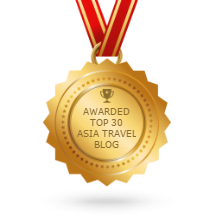Part V: Strolling Along Tiananmen Square
SHARE THIS ARTICLE:
26 September 2006
DAY 2: Aug. 23, 2006 (AM)
After we had our buffet breakfast at the hotel, we took a taxicab and headed to Tiananmen Square. We decided to go first to Mausoleum of Mao Zedong.
Mausoleum is at the south side of the Square. Unfortunately, we didn't know that it was closed on Wednesdays. So, we just had a picture taking in front of the hall. It is said that the mausoleum is a grand villa and it is divided into three halls and Chairman Mao's body lies in a crystal coffin in one of the halls surrounded by fresh bouquets of various famous flowers and grasses. Picture taking inside the mausoleum is not allowed.
Tiananmen Square is the front yard of the Forbidden City. "Tiananmen" is Chinese for "Gate of Heavenly Peace" and it is said to be the biggest square in the whole world. It is 880 meters from south to north , and 500 meters from east to west, with total area of 440,000 square meters and can hold one million people.
I’ve already learned about this place during our history class. The most talked-about was the Tian’anmen Square protests of 1989, also known as the Tian’anmen Square Massacre. It was a series of demonstrations led by students, intellectuals and labor activists between April 15 and June 4, 1989. The movement ended with the government’s crackdown and left many civilians dead. It was witnessed on televisions by millions of people around the world.
The present Tiananmen Square has now become a relaxing place for the common people to fly kites and leisurely walk.


Tiananmen Square is the front yard of the Forbidden City. "Tiananmen" is Chinese for "Gate of Heavenly Peace" and it is said to be the biggest square in the whole world. It is 880 meters from south to north , and 500 meters from east to west, with total area of 440,000 square meters and can hold one million people.
I’ve already learned about this place during our history class. The most talked-about was the Tian’anmen Square protests of 1989, also known as the Tian’anmen Square Massacre. It was a series of demonstrations led by students, intellectuals and labor activists between April 15 and June 4, 1989. The movement ended with the government’s crackdown and left many civilians dead. It was witnessed on televisions by millions of people around the world.
The present Tiananmen Square has now become a relaxing place for the common people to fly kites and leisurely walk.


The Monument of the People's Heroes is the central feature of the Square. Built in the late 1950s to commemorate those who had died for change and revolution in China from 1840, its northern face has a calligraphic inscription by Mao Zedong which reads: "The People's Heroes Live On Forever". Around it, in bas-relief, is an iconographic representation of highlights of the Chinese Revolution.
Around the area, you can also see the Tiananmen Tower, the Great Hall of the People, Monument to the People’s Heroes and Museum of History and the Revolution.
 |
| The Great Hall of the People |
The Great Hall of the People is the place where all major meetings, plenums, congresses and official gatherings of the Chinese Communist Party and government have been held. It is located across the street from the west side of Tian'anmen Square.
The Tiananmen Tower was initially built in 1417 during the Ming Dynasty (1368 A.D.- 1644 A.D.), the Square was the front door of the Forbidden City. The most important use of it in the past was to declare in a big ceremony to the common people who became the emperor and empress. Until 1911 when the last feudal kingdom was over, no one could enter the Tower except for the royal family and aristocrats.



Tiananmen Tower



Built in 1420, the 18th year of Yongle of the Ming Dynasty, the Tiananmen Ornamental Columns are important complements of Tian’anmen’s main structures.

With a height of 9.57 meters and a weight over 20,000 kilos, the columns are carved of white marble. There is a pair of ornamental columns in both front and back of Tian’anmen. On each ornamental column, there is a plate called Cheng Lu Pan for collecting dew, and a crouching animal called Hou.
The two pairs of Stone Lions, 2.2 meters high, carved in 1420, the 18th reign year of Yongle of the Ming Dynasty, stand north and the south of the Golden Water Bridge.

The lions in the east playing with a ball are male and the ones in the west playing with a baby lion are female. They are important complements of Tian’anmen’s main structures.
The place is super HUGE but taxis and buses are not allowed to stop anywhere in the square. We had to use the underpass to cross the road. My legs were already crippling me and I walked lamely due to pain leg muscles, phew!
 SHARE THIS!
SHARE THIS! 




![[tsquare3.jpg]](https://blogger.googleusercontent.com/img/b/R29vZ2xl/AVvXsEilSQU4dLfa7WUpiq8-77tbXhSC8Wy8XfxxsAyIBWkwVVtTr0VvAQScIucyoy-1xChQvD4HoZ2Q9AYY1QWFUK3jYPZMTS0kKnOCD0_9wrsGcTLF8WOQ_8bNzsgQ7j9tRA9tncE/s1600/tsquare3.jpg)





















0 comments